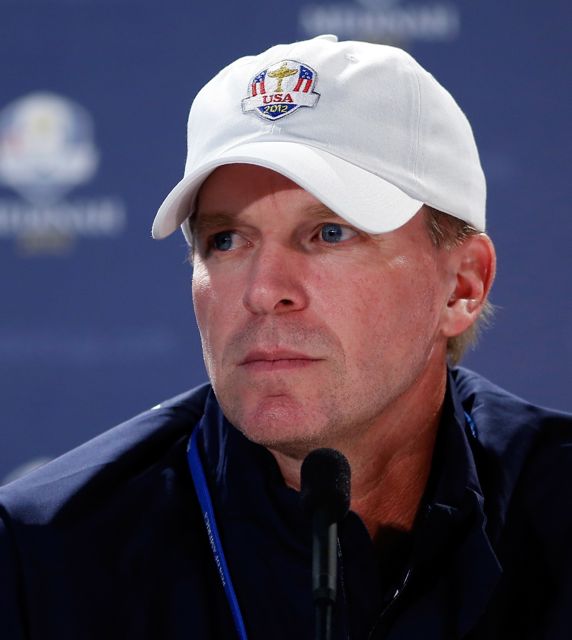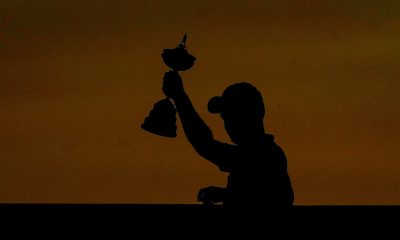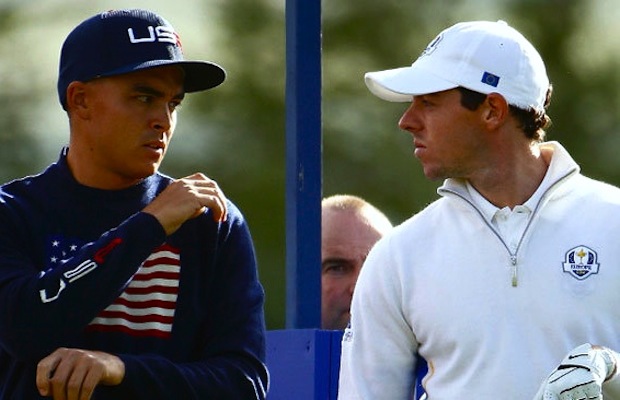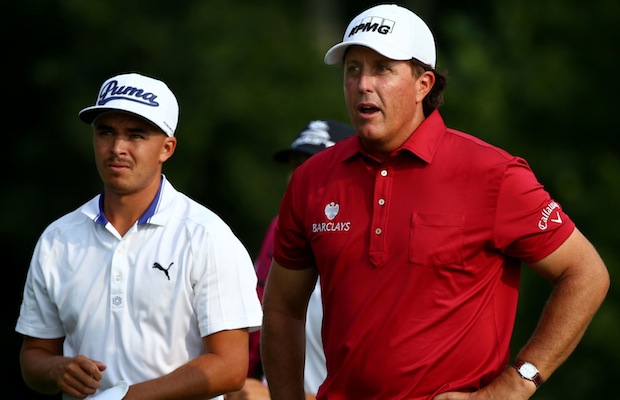Opinion & Analysis
Does the Ryder Cup need a 9th man?

Woulda, coulda, shoulda.
On Wednesday, Tom Watson announced that he would eliminate the fourth captain’s pick and allow the top-nine players on the U.S. Ryder Cup Team to qualify on points.
“There’s not a lot of method in my madness, if you will,” said Watson, 63, who will be the oldest U.S. Ryder Cup captain in history. “I truly think the players themselves ought to have another shot at getting on the team because of … their play.”
In every Ryder Cup, there is always a debate on whether or not the captain’s picks were the correct ones, and there are different schools of thought on the best approach. Should captain’s picks be veteran players who have experience and can mentor the younger guys, or should they be younger players who can provide a spark? Let’s take a hard look at the facts of the last five Ryder Cup matches and get a firm grasp on the importance of those captain’s picks.
CASE STUDY No. 1: 2004 at Oakland Hills
Won by Team Europe (18.5 to 9.5)
The 2004 U.S. Team’s points list had the top-10 point getters making the team, which in this case left veteran player Steve Flesch in the 11th spot. In 2004, Flesch won at Colonial and also tied for seventh at the U.S. Open.
That’s an impressive campaign for most, but it wasn’t enough for captain Hal Sutton to take notice. Sutton eventually went with seasoned veteran Jay Haas, who in 2003 had an impressive showing at the Presidents Cup (he went 2-1-1) and was ranked in the top 20 in the OWGR at the time of his selection to the Ryder Cup. Stewart Cink, who had won twice in 2004 including the prestigious WGC Invitational at Firestone, was the second captain’s pick.
Sutton’s picks were somewhat expected, so there wasn’t a whole lot of discussion about them leading into the matches. Granted, the U.S. got manhandled in the matches, but it was Sutton’s pairings — Phil and Tiger together, mostly — that took most of the heat. Both Cink and Haas finished with records of 1-2-1, which in 2004 was a lot of points for a U.S. player.
Analysis: No amount of clever picks would have been enough for the U.S. to triumph at Oakland Hills.
CASE STUDY No. 2: 2006 at The K Club
Won by Team Europe (18.5 to 9.5)
A good of amount of debate was provided in 2006 as to the captain’s picks and the point system in general. Relatively unknown players like J.J Henry, Vaughn Taylor and Brett Wetterich made the team on points, which led most to believe that the point system was flawed.
John Rollins finished 11th in points and was overlooked so that veterans Stewart Cink and Scott Verplank could be added to the inexperienced squad. Verplank finished the matches with a record of 2-0, which supported captain Tom Lehman’s pick, and Cink who played in all five matches and finished 1-1-3. In the end, much like 2004, it didn’t really matter who Lehman picked because of the birdie onslaught from Team Europe, which was fueled by the inspiring play of Irishman Darren Clarke who had just lost his wife to breast cancer.
Analysis: Hogan, Snead and Nicklaus could have been picked for the squad, but nobody was going to beat Clarke that week, especially on his home turf.
Case Study No. 3: 2008 at Valhalla
Won by the U.S. (16.5 to 11.5)
Captain Paul Azinger made a controversial decision prior to the 2008 matches — he adjusted the qualifications for the U.S. Team to allow only eight players to make it on points, which enabled him to make four captain’s picks.
His pod system proved to be just what the U.S. Team needed to spur them on. He paired players based on personalities rather than their style of play. Even with six rookies on the team, his plan came off without a hitch.
Azinger was able to compensate for the absence of Tiger Woods, who was sidelined with a knee injury. So in this case the “9th player” on the list happened to be the 10th player, Steve Stricker, who in the golf world’s mind was a shoo-in to make the team. Although he provided some fireworks when he halved a match with Ben Curtis against Sergio Garcia and Paul Casey, Stricker finished the matches winless at 0-2-1.
All told, the four captains picks (Hunter Mahan, J.B. Holmes, Steve Stricker and Chad Campbell) finished the matches 6-3-5 and further solidified Captain Azingers model.
Analysis: Although Stricker was the highest-ranked player on the points list (No. 10) and the most experienced, he was the least successful of Azinger’s picks.
Case Study No. 4: 2010 at Celtic Manor
Won by Team Europe (14.5-13.5)
U.S. Team Captain Corey Pavin continued with Azinger’s 2008 model and used four captain’s picks. Pavin decided that injury-laden Anthony Kim, who slipped to 9th in the Ryder Cup standings, would watch the matches from home.
His four captain’s picks of Tiger Woods, Zach Johnson, Ricky Fowler and Stewart Cink finished the week 6-3-5, and left little doubt as to whether Pavin made the right choices. The U.S. Team fought hard in Wales, and if two or three more putts would have gone in perhaps it would have hoisted the cup for a second straight time.
Analysis: Pavin picked the four best players he had access to at that moment, and most agreed that going leaving the injury-plagued Kim off the roster was the right choice.
Case Study No. 5: 2012 at Medinah
Won by Team Europe (14.5 to 13.5)
There was some buzz early in the week in regards to Mahan’s name missing from the roster, but at no point was it 100 percent obvious that Love had made an oversight.
Love’s captains picks of Dustin Johnson, Steve Stricker, Jim Furyk and Brandt Snedeker finished a total of 5-8. The man who shouldered the majority of the scrutiny was Steve Stricker, who finished the week 0-4. But Love’s real mistake was picking Furyk, because there’s just no way an aging Furyk has more value to the future of the U.S. Ryder Cup team than Hunter Mahan, one of the game’s brightest stars who has plenty of Ryder Cup appearances in his future.
Yes, Mahan finished the 2010 Ryder Cup in tears after fatting a chip that could have kept the U.S. in the match, but Furyk blew several tournament leads in 2012, including the Transitions Championship, the U.S. Open and the WGC-Bridgestone Invitational. Shocker that he did the same thing on Sunday at the Ryder Cup, right?
Analysis: Strickers’ 0-4 record and Furyk’s meltdown on the final holes started this debate. In retrospect, either or both of them probably should have been replaced with Hunter Mahan and Nick Watney, all in their early 30s.
The Takeaway
Having the access to pick four key Ryder Cup players seems like a great weapon for a captain to have, but it’s hard to prove that picks have faired any better than comparable players would have over the years. Keeping that in mind, Watson might have a point — what’s wrong with putting the responsibility of the team’s success on the shoulders of the players to qualify?
Up until 1989, that’s how all players qualified for the U.S. Team. And get this, the U.S. completely dominated the Ryder Cup. If you take a look back at how captains have used their picks, they were often to add a couple of experienced veterans (or friends) to the roster. Rarely has a captain used a pick to select a younger player.
If the U.S. Team went back to the old format, there’d be no picks and no debate — just simple math. I can assure you that the guy who is in the 13th spot is going to make sure he’s never there again, sort of like the guy who landed at 126th on the money list. Motivation works in mysterious ways and what it does to a player is amazing.
Click here to see what people are saying in the Tour Talk forum.
Opinion & Analysis
The 2 primary challenges golf equipment companies face

As the editor-in-chief of this website and an observer of the GolfWRX forums and other online golf equipment discourse for over a decade, I’m pretty well attuned to the grunts and grumbles of a significant portion of the golf equipment purchasing spectrum. And before you accuse me of lording above all in some digital ivory tower, I’d like to offer that I worked at golf courses (public and private) for years prior to picking up my pen, so I’m well-versed in the non-degenerate golf equipment consumers out there. I touched (green)grass (retail)!
Complaints about the ills of and related to the OEMs usually follow some version of: Product cycles are too short for real innovation, tour equipment isn’t the same as retail (which is largely not true, by the way), too much is invested in marketing and not enough in R&D, top staffer X hasn’t even put the new driver in play, so it’s obviously not superior to the previous generation, prices are too high, and on and on.
Without digging into the merits of any of these claims, which I believe are mostly red herrings, I’d like to bring into view of our rangefinder what I believe to be the two primary difficulties golf equipment companies face.
One: As Terry Koehler, back when he was the CEO of Ben Hogan, told me at the time of the Ft Worth irons launch, if you can’t regularly hit the golf ball in a coin-sized area in the middle of the face, there’s not a ton that iron technology can do for you. Now, this is less true now with respect to irons than when he said it, and is less and less true by degrees as the clubs get larger (utilities, fairways, hybrids, drivers), but there remains a great deal of golf equipment truth in that statement. Think about it — which is to say, in TL;DR fashion, get lessons from a qualified instructor who will teach you about the fundamentals of repeatable impact and how the golf swing works, not just offer band-aid fixes. If you can’t repeatably deliver the golf club to the golf ball in something resembling the manner it was designed for, how can you expect to be getting the most out of the club — put another way, the maximum value from your investment?
Similarly, game improvement equipment can only improve your game if you game it. In other words, get fit for the clubs you ought to be playing rather than filling the bag with the ones you wish you could hit or used to be able to hit. Of course, don’t do this if you don’t care about performance and just want to hit a forged blade while playing off an 18 handicap. That’s absolutely fine. There were plenty of members in clubs back in the day playing Hogan Apex or Mizuno MP-32 irons who had no business doing so from a ballstriking standpoint, but they enjoyed their look, feel, and complementary qualities to their Gatsby hats and cashmere sweaters. Do what brings you a measure of joy in this maddening game.
Now, the second issue. This is not a plea for non-conforming equipment; rather, it is a statement of fact. USGA/R&A limits on every facet of golf equipment are detrimental to golf equipment manufacturers. Sure, you know this, but do you think about it as it applies to almost every element of equipment? A 500cc driver would be inherently more forgiving than a 460cc, as one with a COR measurement in excess of 0.83. 50-inch shafts. Box grooves. And on and on.
Would fewer regulations be objectively bad for the game? Would this erode its soul? Fortunately, that’s beside the point of this exercise, which is merely to point out the facts. The fact, in this case, is that equipment restrictions and regulations are the slaughterbench of an abundance of innovation in the golf equipment space. Is this for the best? Well, now I’ve asked the question twice and might as well give a partial response, I guess my answer to that would be, “It depends on what type of golf you’re playing and who you’re playing it with.”
For my part, I don’t mind embarrassing myself with vintage blades and persimmons chasing after the quasi-spiritual elevation of a well-struck shot, but that’s just me. Plenty of folks don’t give a damn if their grooves are conforming. Plenty of folks think the folks in Liberty Corner ought to add a prison to the museum for such offences. And those are just a few of the considerations for the amateur game — which doesn’t get inside the gallery ropes of the pro game…
Different strokes in the game of golf, in my humble opinion.
Anyway, I believe equipment company engineers are genuinely trying to build better equipment year over year. The marketing departments are trying to find ways to make this equipment appeal to the broadest segment of the golf market possible. All of this against (1) the backdrop of — at least for now — firm product cycles. And golfers who, with their ~15 average handicap (men), for the most part, are not striping the golf ball like Tiger in his prime and seem to have less and less time year over year to practice and improve. (2) Regulations that massively restrict what they’re able to do…
That’s the landscape as I see it and the real headwinds for golf equipment companies. No doubt, there’s more I haven’t considered, but I think the previous is a better — and better faith — point of departure when formulating any serious commentary on the golf equipment world than some of the more cynical and conspiratorial takes I hear.
Agree? Disagree? Think I’m worthy of an Adam Hadwin-esque security guard tackle? Let me know in the comments.
@golfoncbs The infamous Adam Hadwin tackle ? #golf #fyp #canada #pgatour #adamhadwin ? Ghibli-style nostalgic waltz – MaSssuguMusic
Podcasts
Fore Love of Golf: Introducing a new club concept

Episode #16 brings us Cliff McKinney. Cliff is the founder of Old Charlie Golf Club, a new club, and concept, to be built in the Florida panhandle. The model is quite interesting and aims to make great, private golf more affordable. We hope you enjoy the show!
Opinion & Analysis
On Scottie Scheffler wondering ‘What’s the point of winning?’

Last week, I came across a reel from BBC Sport on Instagram featuring Scottie Scheffler speaking to the media ahead of The Open at Royal Portrush. In it, he shared that he often wonders what the point is of wanting to win tournaments so badly — especially when he knows, deep down, that it doesn’t lead to a truly fulfilling life.
View this post on Instagram
“Is it great to be able to win tournaments and to accomplish the things I have in the game of golf? Yeah, it brings tears to my eyes just to think about it because I’ve literally worked my entire life to be good at this sport,” Scheffler said. “To have that kind of sense of accomplishment, I think, is a pretty cool feeling. To get to live out your dreams is very special, but at the end of the day, I’m not out here to inspire the next generation of golfers. I’m not out here to inspire someone to be the best player in the world, because what’s the point?”
Ironically — or perhaps perfectly — he went on to win the claret jug.
That question — what’s the point of winning? — cuts straight to the heart of the human journey.
As someone who’s spent over two decades in the trenches of professional golf, and in deep study of the mental, emotional, and spiritual dimensions of the game, I see Scottie’s inner conflict as a sign of soul evolution in motion.
I came to golf late. I wasn’t a junior standout or college All-American. At 27, I left a steady corporate job to see if I could be on the PGA Tour starting as a 14-handicap, average-length hitter. Over the years, my journey has been defined less by trophies and more by the relentless effort to navigate the deeply inequitable and gated system of professional golf — an effort that ultimately turned inward and helped me evolve as both a golfer and a person.
One perspective that helped me make sense of this inner dissonance around competition and our culture’s tendency to overvalue winning is the idea of soul evolution.
The University of Virginia’s Division of Perceptual Studies has done extensive research on reincarnation, and Netflix’s Surviving Death (Episode 6) explores the topic, too. Whether you take it literally or metaphorically, the idea that we’re on a long arc of growth — from beginner to sage elder — offers a profound perspective.
If you accept the premise literally, then terms like “young soul” and “old soul” start to hold meaning. However, even if we set the word “soul” aside, it’s easy to see that different levels of life experience produce different worldviews.
Newer souls — or people in earlier stages of their development — may be curious and kind but still lack discernment or depth. There is a naivety, and they don’t yet question as deeply, tending to see things in black and white, partly because certainty feels safer than confronting the unknown.
As we gain more experience, we begin to experiment. We test limits. We chase extreme external goals — sometimes at the expense of health, relationships, or inner peace — still operating from hunger, ambition, and the fragility of the ego.
It’s a necessary stage, but often a turbulent and unfulfilling one.
David Duval fell off the map after reaching World No. 1. Bubba Watson had his own “Is this it?” moment with his caddie, Ted Scott, after winning the Masters.
In Aaron Rodgers: Enigma, reflecting on his 2011 Super Bowl win, Rodgers said:
“Now I’ve accomplished the only thing that I really, really wanted to do in my life. Now what? I was like, ‘Did I aim at the wrong thing? Did I spend too much time thinking about stuff that ultimately doesn’t give you true happiness?’”
Jim Carrey once said, “I think everybody should get rich and famous and do everything they ever dreamed of so they can see that it’s not the answer.”
Eventually, though, something shifts.
We begin to see in shades of gray. Winning, dominating, accumulating—these pursuits lose their shine. The rewards feel more fleeting. Living in a constant state of fight-or-flight makes us feel alive, yes, but not happy and joyful.
Compassion begins to replace ambition. Love, presence, and gratitude become more fulfilling than status, profits, or trophies. We crave balance over burnout. Collaboration over competition. Meaning over metrics.
Interestingly, if we zoom out, we can apply this same model to nations and cultures. Countries, like people, have a collective “soul stage” made up of the individuals within them.
Take the United States, for example. I’d place it as a mid-level soul: highly competitive and deeply driven, but still learning emotional maturity. Still uncomfortable with nuance. Still believing that more is always better. Despite its global wins, the U.S. currently ranks just 23rd in happiness (as of 2025). You might liken it to a gifted teenager—bold, eager, and ambitious, but angsty and still figuring out how to live well and in balance. As much as a parent wants to protect their child, sometimes the child has to make their own mistakes to truly grow.
So when Scottie Scheffler wonders what the point of winning is, I don’t see someone losing strength.
I see someone evolving.
He’s beginning to look beyond the leaderboard. Beyond metrics of success that carry a lower vibration. And yet, in a poetic twist, Scheffler did go on to win The Open. But that only reinforces the point: even at the pinnacle, the question remains. And if more of us in the golf and sports world — and in U.S. culture at large — started asking similar questions, we might discover that the more meaningful trophy isn’t about accumulating or beating others at all costs.
It’s about awakening and evolving to something more than winning could ever promise.

























GAMES
May 2, 2013 at 7:46 pm
Picking the #10 player in the world (Stricker) over #19 (Mahan) and #29 (Watney) was a no-brainer. No one could have seen Stricker’s 0-4 record coming.
BTW, if the same decision had to be made today, picking Stricker would be EVEN MORE of a no-brainer as he has moved UP to #9 in the world, while Mahan and Watney have both fallen three spots, to #22 and #23, respectively.
I know Steve Stricker’s modest midwest demeanor doesn’t play well with you people on the coasts. But, the reality is Stricker simply was AND IS a better player than either Watney or Mahan…
Brandon
Mar 25, 2013 at 12:01 pm
I still think leaving Mahan off last years team was a mistake, especially considering how well he plays in match play. I definitely like the idea of one less captains picks I would say get rid of them all together and just take the top 12 at the time. I don’t think you can go wrong with pick the guys who are playing the best that year.